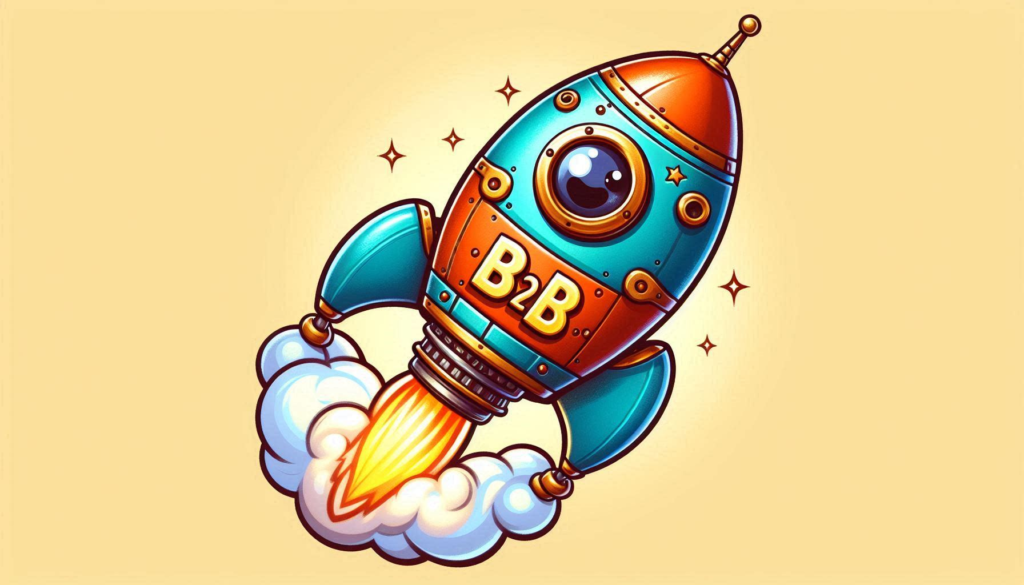Generative AI Meets B2B Marketing: Insider Secrets to Skyrocket Engagement & ROI
Beyond the Hype: Real ROI from Generative AI in B2B Marketing Blog Series
Welcome back to our series on harnessing the ROI of generative AI in B2B marketing. In this installment, we’ll delve into the practical applications of generative AI and how it can seamlessly integrate into your marketing strategy to skyrocket engagement and ROT. By the end of this blog, you’ll have a clear roadmap to effectively integrate this powerful technology into your marketing operations, reaping its numerous benefits and sparking a new era of innovation in your marketing approach.
Assess Your Needs
Before you embark on the thrilling journey of implementing generative AI, it’s crucial to assess your marketing needs and identify areas where this technology can be a game-changer. This involves closely examining your current processes, identifying the pain points, and envisioning how generative AI can solve these challenges, setting the stage for a more efficient and effective marketing strategy.
Identify Areas for Improvement
Start by examining your marketing workflows. Are there tasks that are time-consuming or repetitive? Do you need help with content creation or personalization at scale? Identifying these pain points will help you understand where generative AI can be most beneficial.
Set Goals and KPIs
Next, define what success looks like for your generative AI initiatives. This could be increasing content output, improving personalization, or enhancing customer engagement. Establishing clear goals and key performance indicators (KPIs) will guide your implementation and help measure its impact.
Choose the Right Tools
With your goals and needs in mind, the next step is selecting the right generative AI tools. There are many AI platforms available, each with unique features and capabilities. Here are some factors to consider when choosing a tool:
Content Generation Capabilities
- Ability to generate high-quality, engaging content such as blog posts, articles, whitepapers, email copy, and social media posts.
- Customization options to tailor content to your brand voice, target audience, and specific marketing goals.
- Support for multiple content formats like text, images, and video.
Natural Language Processing (NLP)
- Advanced NLP capabilities to understand and respond to user queries in a human-like manner.
- Ability to analyze and generate content based on context and user intent.
- Support for multiple languages if you have a global audience.
Personalization and Targeting
- Ability to personalize content, offers, and experiences based on individual customer profiles and behaviors.
- Capability to analyze customer data and generate insights for targeted marketing campaigns.
- Features like dynamic content insertion and behavioral targeting.
Automation and Optimization
- Automated content creation, distribution, and optimization capabilities that can significantly enhance your team’s productivity and efficiency, freeing up time and resources for other strategic tasks.
- Built-in A/B testing and optimization features to improve content performance over time.
- Ability to automate repetitive tasks like lead scoring, email campaigns, and ad management.
Analytics and Reporting
- Robust analytics to track content performance, user engagement, and conversion rates.
- Ability to generate actionable insights and recommendations based on data analysis .
- Integration with marketing analytics platforms for a comprehensive view of performance.
Scalability and Performance
- Ability to handle large volumes of content creation and personalization needs as your marketing efforts grow.
- Fast content generation and real-time personalization capabilities.
- Reliable uptime and robust infrastructure to ensure consistent performance.
Compatibility and Integration
- Seamless integration with your existing marketing technology stack and CRM systems.
- Compatibility with your current workflows to streamline implementation and maximize efficiency.
- Ability to connect with and leverage your existing customer data for personalization.
Ease of Use and Support
- Intuitive user interface and easy-to-use tools that are designed with your needs and preferences in mind, ensuring a seamless user experience.
- Comprehensive documentation, tutorials, and customer support.
- Regular updates and feature enhancements based on user feedback and evolving marketing needs.
Data Security and Compliance
- Robust data security measures that prioritize the protection of your sensitive customer information, ensuring your data is safe and secure.
- Compliance with relevant data privacy regulations like GDPR and CCPA.
- Transparent data usage policies and user consent management features.
Customization and Flexibility
Select AI tools offering customization options to tailor its functionality to your needs. Flexibility in terms of content generation and personalization features is essential.
A Recap of Choosing the Right Tools
Start by evaluating generative AI tools based on these critical features and capabilities. Then, request demos or trials to see the tool in action. It’s crucial to gather feedback from other users to get a comprehensive understanding and ensure your team’s needs are considered. Finally, consider the long-term scalability, vendor support, and roadmap for future enhancements. This inclusive approach ensures that the tool aligns with your team’s goals and needs before making a final decision.
Specific AI Tools and Their Applications in B2B Marketing
OpenAI GPT-4o
One of the most advanced language models available today is GPT-4o, developed by OpenAI. This tool can generate human-like text based on input, making it robust for content creation, customer support, and more. Let’s explore its applications in B2B marketing.
- GPT-4o Applications in B2B Marketing:
- Content Creation: GPT-4o can generate blog posts, articles, and whitepapers that are coherent and tailored to your audience. B2B marketers use it to produce high-quality content quickly, freeing up time for strategy and engagement.
- Email Campaigns: GPT-4o can personalize email content based on customer data, improving open and click-through rates. This personalization makes emails feel more relevant to the recipient, enhancing engagement.
- Chatbots: Many companies use GPT-4o to power them, providing instant, accurate responses to customer inquiries. This improves customer service and frees up human agents for more complex tasks.
HubSpot’s Content Strategy Tool
HubSpot’s Content Strategy Tool uses AI to help marketers plan and optimize content. It analyzes search data, identifies content gaps, and suggests topics likely to perform well.
- HubSpot’s Applications in B2B Marketing:
- SEO Optimization: The tool suggests keywords and topics to improve search engine rankings, helping B2B companies attract more organic traffic.
- Content Planning: Marketers use the tool to identify high-potential topics and create a content calendar that aligns with audience interests and business goals.
- Performance Tracking: HubSpot’s AI-driven analytics track content performance, providing insights that help marketers refine their strategies over time.
Salesforce Einstein
Salesforce Einstein is an AI-powered platform with predictive analytics, natural language processing, and machine learning capabilities. It helps businesses automate tasks, gain insights, and personalize customer interactions.
- Einstein’s Applications in B2B Marketing:
- Lead Scoring: Einstein uses AI to score leads based on their conversion likelihood, allowing sales teams to focus on the most promising prospects.
- Personalized Marketing: The platform analyzes customer data to deliver personalized recommendations and content, improving engagement and conversion rates.
- Predictive Analytics: Einstein provides predictive insights that help marketers forecast trends, optimize campaigns, and make data-driven decisions.
Marketo Engage
Marketo Engage, part of Adobe’s suite of marketing tools, leverages AI to enhance marketing automation, lead management, and customer engagement.
- Marketo Engage Applications in B2B Marketing:
- Account-Based Marketing (ABM): Marketo’s AI capabilities help marketers identify high-value accounts and create personalized campaigns that resonate with key decision-makers.
- Lead Nurturing: The platform automates lead nurturing workflows, delivering personalized content and messages based on a lead’s behavior and engagement level.
- Predictive Content: Marketo uses AI to recommend content that is likely to engage and convert specific audience segments.
Phrasee
Phrasee uses AI to generate optimized email subject lines, push notifications, and social media messages. It analyzes language patterns to create content that drives engagement and conversions.
- Phrasee Applications in B2B Marketing:
- Email Marketing: Phrasee generates email subject lines that improve open rates by appealing to the target audience’s preferences and behaviors.
- Social Media: The tool crafts social media messages designed to increase likes, shares, and comments, enhancing brand visibility and engagement.
- A/B Testing: Phrasee’s AI-driven testing capabilities help marketers determine which language resonates best with their audience, optimizing campaign performance.
Integration and Execution of Your Generative AI Tools
Once you’ve chosen the right tools, it’s time to integrate generative AI into your marketing processes. Here are some best practices for a smooth implementation:
Pilot Projects
Start with small pilot projects to test the effectiveness of generative AI. This will allow you to evaluate its impact, gather feedback, and make necessary adjustments before scaling up.
Training and Support
Provide training and support to ensure your team is comfortable using the new AI tools. This may include workshops, online courses, or one-on-one training sessions.
Workflow Integration
Incorporate generative AI into your existing workflows to maximize efficiency. This might involve automating content creation, personalizing marketing messages, or using AI-generated insights to inform your strategy.
Monitoring and Optimization
Implementing generative AI is a collaborative effort. Continuous monitoring and optimization are essential to ensure long-term success and maximize ROI.
Performance Tracking
Regularly track the performance of your AI initiatives using the KPIs you established earlier. This will help you identify what’s working and where improvements are needed.
Feedback and Iteration
Gather feedback from your team and audience to refine your AI-generated content and strategies continuously. Use this feedback to make data-driven adjustments and improvements.
Don’t Get Left Behind: Commit to Continuous Learning as AI Transforms B2B Marketing
Staying ahead of the curve in the rapidly evolving world of generative AI is not just crucial for B2B marketers, it’s an exciting adventure. As new tools, features, and best practices emerge at a breakneck pace, continuous learning becomes the key to unlocking the transformative power of AI in your marketing efforts. By dedicating time to exploring the latest advancements, experimenting with cutting-edge techniques, and learning from the successes of industry pioneers, you’ll not only position yourself to ride the wave of innovation but also to shape it. Embrace the challenge of lifelong learning, and you’ll be rewarded with a marketing strategy that’s not just relevant and revolutionary, but one that propels your B2B brand to new heights of engagement, efficiency, and growth. So, keep your curiosity alive, your mind open, and your skills sharp – the future of marketing is yours to shape!
Embrace the AI Revolution: Your Path to Marketing Mastery Starts Now
Generative AI is not just the future of B2B marketing – it’s the present. By assessing your needs, setting clear goals, choosing the right tools, and implementing them strategically, you can harness the power of AI to revolutionize your marketing efforts. The possibilities are endless, from creating compelling content at scale to personalizing customer experiences. But remember, success with AI is not a one-time event; it’s a journey of continuous learning, iteration, and optimization. Stay curious, stay adaptable, and stay ahead of the curve. The AI revolution in B2B marketing is here, and it’s time for you to seize the opportunity. Start small, think big, and watch as generative AI transforms your marketing strategy into a powerhouse of innovation, efficiency, and unparalleled results. The future is yours to shape – embrace it with open arms and an open mind.
I hope you are enjoying this blog series. In my next blog, we’ll explore how you can measure the ROI of generative AI in your B2B marketing. I aim to offer you practical tips and insights to help you track your performance and demonstrate the value of your AI marketing initiatives. As a marketer, I empathize with the burden that marketing shoulders in proving worth. At Thulium, we are always committed to serving global marketing teams like yours and offering cutting-edge solutions to elevate your team within your organization. If there’s anything I’ve missed in this post or a question you have, please comment below, and one of our Thulium team members will be prompt in responding.
*This blog post is a collaborative effort between my insights and the capabilities of generative AI, blending human experience with advanced technology. Image created by DALL-E using the prompt, “Please create an image of a rocket ship with the letters B2B on the rocket ship.” Note: It took sixteen iterations to get the letters B2B correctly spelled on the rocket ship.



